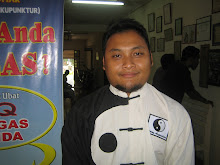Friday, May 13, 2011
TCM and Infectious Diseases
TCM and Infectious Disease
By John Chen, PhD, PharmD, OMD, LAc
In traditional Chinese medicine, the first reference to infectious disease appeared in Huang Di Nei Jing (Yellow Emperor's Inner Classic) compiled in the first or second century C.E.
This text discussed the presence of Re Bing (hot disease), which according to our understanding today, refers to the various types of infectious disease.
The understanding of infectious disease progressed further during the Ming and Qing dynasties as many people in Southern China suffered and died from a variety of feverish conditions. Many doctors recognized that these patterns of illness were significantly different from shang han (cold damage) patterns, and therefore, must be diagnosed and treated differently. W Yu-Xìng, Yè Guì, and Wú Táng, three of the most influential doctors during that era, collectively contributed to a new school of thought, namely wen bing (warm disease). According to this new theory, warm and hot disease plagued everyone, starting "from one person to the entire household, from one household to the entire street, and from one street to the entire village." When affected, the disease first affected the exterior of the body, and progressed to the interior, following the patterns of wei (defensive), qi (energy), ying (nutritive), and xue (blood) levels. Furthermore, it was observed that the cause of these warm and hot disease have "no sound nor smell, and no shape nor shadow." In addition, it was noted that the warm and hot disease may be transmitted from one person to another via "heaven (air borne)" or "earth (direct contact)," and affect weak, deficient individuals (i.e., those with low immunity).
Lastly, many of the bitter and cold herbs and formulas used to treat these warm and hot diseases are recognized today to have remarkable antibiotic effects. These observations are made and published approximately 200 years before the discovery of bacteria and other micro-organisms. Wen bing (warm disease) theories accurately described the origins and transmission of epidemic disease, and the importance of the immune system in relationship to the pathogens. Wen bing (warm disease) theories revolutionized and significantly influenced the theory and practice of traditional Chinese medicine, changes that persist even today.
Prevention of Infectious Disease
One of the fundamental concepts in traditional Chinese medicine is that "superior medicine prevents disease, and inferior medicine treats disease." Prevention of infectious disease is certainly no exception since bacteria and virus tend to adversely affect those who have weakened or compromised immune systems. Many herbs and formulas that tonify wei (defensive) qi have been shown to have marked effect to boost the immune system. Examples include:
Classic formulas with immunostimulant effect:
* Shi Quan Da Bu Tang (All-Inclusive Great Tonifying Decoction)
* Ren Shen Yang Ying Tang (Ginseng Decoction to Nourish the Nutritive Qi)
* Bu Zhong Yi Qi Tang (Tonify the Middle and Augment the Qi Decoction)
* Si Jun Zi Tang (Four-Gentlemen Decoction)
* Yu Ping Feng San (Jade Windscreen Powder)
By John Chen, PhD, PharmD, OMD, LAc
In traditional Chinese medicine, the first reference to infectious disease appeared in Huang Di Nei Jing (Yellow Emperor's Inner Classic) compiled in the first or second century C.E.
This text discussed the presence of Re Bing (hot disease), which according to our understanding today, refers to the various types of infectious disease.
The understanding of infectious disease progressed further during the Ming and Qing dynasties as many people in Southern China suffered and died from a variety of feverish conditions. Many doctors recognized that these patterns of illness were significantly different from shang han (cold damage) patterns, and therefore, must be diagnosed and treated differently. W Yu-Xìng, Yè Guì, and Wú Táng, three of the most influential doctors during that era, collectively contributed to a new school of thought, namely wen bing (warm disease). According to this new theory, warm and hot disease plagued everyone, starting "from one person to the entire household, from one household to the entire street, and from one street to the entire village." When affected, the disease first affected the exterior of the body, and progressed to the interior, following the patterns of wei (defensive), qi (energy), ying (nutritive), and xue (blood) levels. Furthermore, it was observed that the cause of these warm and hot disease have "no sound nor smell, and no shape nor shadow." In addition, it was noted that the warm and hot disease may be transmitted from one person to another via "heaven (air borne)" or "earth (direct contact)," and affect weak, deficient individuals (i.e., those with low immunity).
Lastly, many of the bitter and cold herbs and formulas used to treat these warm and hot diseases are recognized today to have remarkable antibiotic effects. These observations are made and published approximately 200 years before the discovery of bacteria and other micro-organisms. Wen bing (warm disease) theories accurately described the origins and transmission of epidemic disease, and the importance of the immune system in relationship to the pathogens. Wen bing (warm disease) theories revolutionized and significantly influenced the theory and practice of traditional Chinese medicine, changes that persist even today.
Prevention of Infectious Disease
One of the fundamental concepts in traditional Chinese medicine is that "superior medicine prevents disease, and inferior medicine treats disease." Prevention of infectious disease is certainly no exception since bacteria and virus tend to adversely affect those who have weakened or compromised immune systems. Many herbs and formulas that tonify wei (defensive) qi have been shown to have marked effect to boost the immune system. Examples include:
Classic formulas with immunostimulant effect:
* Shi Quan Da Bu Tang (All-Inclusive Great Tonifying Decoction)
* Ren Shen Yang Ying Tang (Ginseng Decoction to Nourish the Nutritive Qi)
* Bu Zhong Yi Qi Tang (Tonify the Middle and Augment the Qi Decoction)
* Si Jun Zi Tang (Four-Gentlemen Decoction)
* Yu Ping Feng San (Jade Windscreen Powder)
Subscribe to:
Post Comments (Atom)





No comments:
Post a Comment